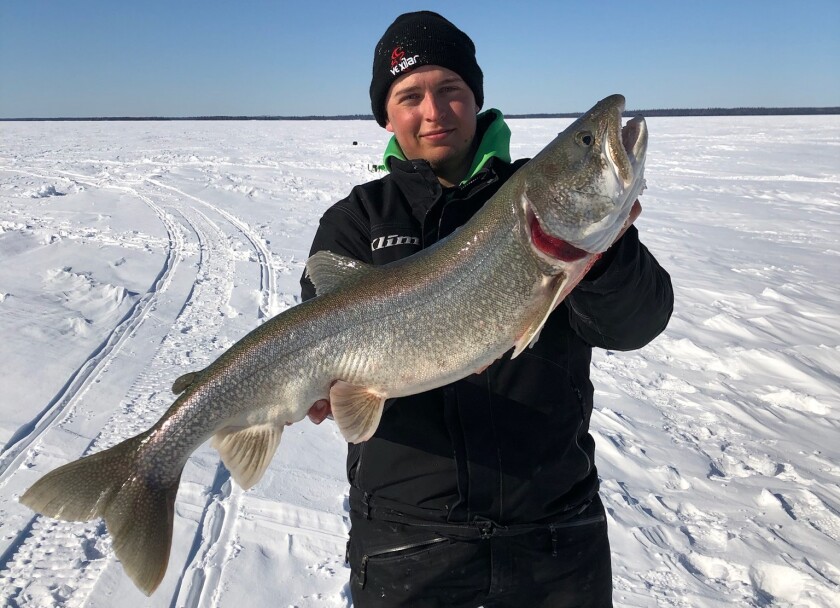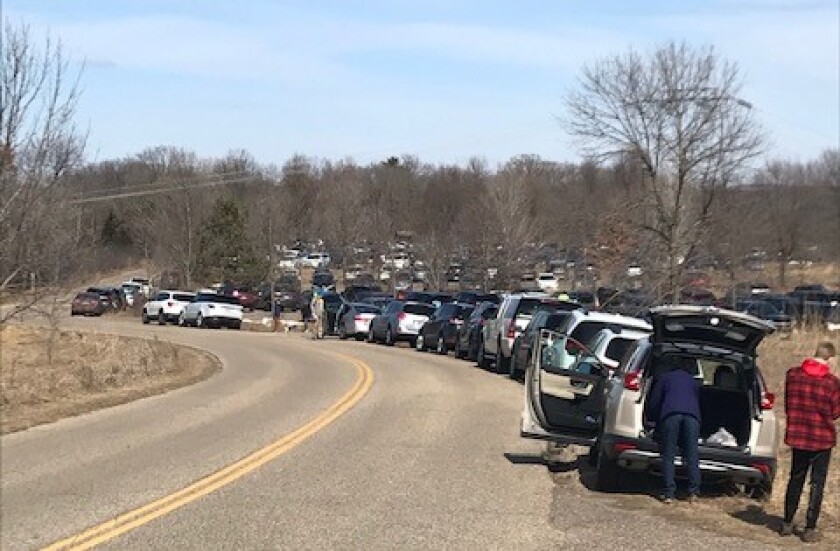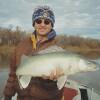Harley McMillin and his son, Trevor, were lake trout fishing in northern Manitoba that fateful week in March 2020, when they started hearing rumblings about the U.S.-Canada border closing in response to increasing reports of a new coronavirus dubbed COVID-19.
They decided to cut their trip short and head home a day early – just to be safe. The U.S.-Canada border closed to nonessential travel on March 21, 2020, the day McMillin and his son hightailed it back to the states. Canada wouldn’t reopen its border until Aug. 9, 2021, while the U.S. border would remain closed until Nov. 8, 2021.
ADVERTISEMENT

“We’re up there and we’re hearing all this stuff about the border possibly closing, and then all of a sudden, it really sounded like it was going to happen,” McMillin, of Roseau, Minnesota, said. “I knew they’d let us back in the (U.S.), but we didn’t want to go through a bunch of rigmarole, either.
“It was really ramping up fast. At first, I thought they’d never do it.”
It’s been five years since the COVID-19 pandemic brought normal life to a grinding halt. Things that people took for granted, such as going to sporting events, concerts or restaurants, suddenly were off-limits as people were told to stay home and keep their distance from each other to minimize the risk of spreading the highly contagious coronavirus.
Hand sanitizer, masks and social distancing became buzzwords of the day.
In response, people turned to the outdoors and activities such as fishing, hiking and birdwatching for solace and sanity. Soaring state park visits and record fishing license sales were just two examples.
The Herald recently visited with a handful of people with ties to the great outdoors to get their thoughts on the pandemic and the state of outdoor participation five years later.
‘Itching to get out’
“People were just itching to get out of the house and do something,” said Sara Berhow, integrated public relations supervisor for the Minnesota Department of Natural Resources’ Parks and Trails Division in St. Paul. “Places close to a population center really were overwhelmed in those early days.”
ADVERTISEMENT

The Parks and Trails Division canceled popular interpretive programs because people weren’t supposed to gather in groups, Berhow recalls. Some parks staff were reassigned to other jobs, such as managing the influx of park visitors at the busiest sites, while others temporarily were reassigned to other agencies, such as the state Department of Health, she says.
“It was a little chaotic in those early days,” Berhow said.
By the summer of 2022, though, park activities and offerings were “kind of back to normal,” Berhow said. Five years later, park visitation and overnight use remain higher than pre-pandemic levels, she says.
In 2020, for example, 12.2 million people visited Minnesota state parks, compared with 9.3 million in 2019, DNR figures show. Visitations have remained around 11 million each of the past three years. At the same time, more people are visiting state parks during the “shoulder” seasons of April, September and October, Berhow says.
North Dakota state parks experienced a similar uptick in visitors, with a 25% increase in camping permits in 2020 and a 20% increase in state park permit sales, Herald archives show. The state Parks and Recreation Department didn’t respond to a request for more recent numbers before the deadline for this story.
“I can say we’ve returned to normal, but in some sense, it’s a new normal because of the visitation numbers,” the DNR’s Berhow said. “There are people who found the outdoors during the early days of the pandemic and learned that it’s pretty great to spend time outside and they’ve continued to do that.”
State parks remain popular destinations, but fishing license sales have been on a slow decline since peaking in 2020. In Minnesota, for example, DNR statistics show a whopping 498,094 residents bought individual angling licenses in 2020. By 2023, that number had dipped to 446,191.
ADVERTISEMENT
In North Dakota, fishing licenses sales peaked at 227,511 – 161,967 residents and 65,544 nonresidents – in 2020, only to drop to 196,371 by 2022, even though fishing in the state has rarely been better.
“We did see a large COVID bump in license sales (and participation) in 2020, but it went away too fast,” said Greg Power, fisheries chief for the North Dakota Game and Fish Department in Bismarck. “By 2022, we were back to pre-COVID numbers.”
Tourism adjustments
With the uptick in outdoors participation, tourism providers scrambled to follow the barrage of rules and regulations that were implemented to try and mitigate the spread of COVID-19.
Joe Henry, executive director of Lake of the Woods Tourism, says he’d just gotten to Sioux Falls, South Dakota, to set up for a popular mid-March outdoors sports show in 2020 when he got word that the show was canceled. Henry promotes the Lake of the Woods area at numerous sports shows throughout the winter months.
“Everything’s in place,” he recalled this week. “The boats are in, the RVs are in and – boom! – the show was canceled. There were people wheeling stuff out (of the venue) past me saying, ‘Turn around, show’s canceled.’ ”
So began perhaps the strangest time in Henry’s tenure as tourism director. Within days, its four county-owned boat ramps on the Rainy River to prevent the influx of anglers who converge on the border river by the thousands for the spring walleye run. The city of Baudette followed suit, closing the two landings it owns in city limits. As the May fishing opener approached, resorts struggled to keep abreast of regulations and guidelines the state had put in place to prevent people from gathering in large groups.
“I can remember sending emails out that had everything from proper cleaning protocols to how to decipher a state of Minnesota law about reopening,” Henry said.
ADVERTISEMENT
Once things started opening up a bit, resorts on the south end of Lake of the Woods enjoyed a boom in tourism, Henry said, driven by anglers who couldn’t make their usual trips to Canada and families whose kids weren’t participating in traditional summer activities.
“Even during COVID, people wanted to get out and outdoor recreate, and they wanted to get outside and away from people, so fishing was perfect for that,” Henry said. “Our resorts, they had to go through a lot – the cleaning and how many people could be in their bar and restaurant and having to take some tables out so people would be spread apart, making sure employees were protected with proper personal safety gear.”
As if running a resort wasn’t difficult enough already.
“In true entrepreneurial spirit, these resorts stepped up, and got ‘er done and they made it through,” Henry said.
Tough times at the Angle
The story was different up at the Northwest Angle, which is only accessible by road by driving through about 30 miles of Manitoba. With the border closed, tourism at the Angle plummeted because people couldn’t get there.
“They couldn’t have Canadians or Americans come to their resorts because you couldn’t cross that border,” Henry said.
Losing the summer of 2020 was bad enough, but as the winter of 2021 approached with no sign of easing border restrictions, “Angle ingenuity” went to work, Henry recalls, setting the stage for a 38-mile ice road from Springsteel Resort north of Warroad and across the lake to the Northwest Angle.
ADVERTISEMENT
The ice road, which allowed visitors to stay in Minnesota while traveling to the Angle, drew worldwide attention, Henry says, and likely saved some resorts.
“Everybody at the Angle had a piece in it,” Henry said. “Everybody contributed financially and everybody had their different roles, whether plowing or clearing trails or making ice bridges or manning the road.”
Lake Region perspective
As with the south end of Lake of the Woods, the Devils Lake region’s tourism industry was able to weather the pandemic quite well, recalls Suzie Kenner, executive director of Devils Lake Tourism. Devils Lake also attracted anglers who couldn’t make their regular fishing trips to Canada.
“When the world shut down and the state shut down, we had the natural resources where everybody was still able to get out or take a vacation with their families and enjoy our wide open spaces and the lake and everything it had to offer,” Kenner said.
Five years later, that momentum has been sustained, she said.
“A lot of people are still continuing to come here on a yearly basis instead of going elsewhere,” Kenner said. “We have an outstanding fishery and it’s well maintained. A lot of people have good luck fishing here, and it’s a fun place to fish because it’s a lake where you can use any presentation that you want when you’re fishing and still be able to catch fish.”
As life got back to normal and COVID concerns subsided, Henry of Lake of the Woods Tourism said there was “kind of a burst” in tourism the first couple of years.
ADVERTISEMENT
“People were pent up,” he said. “They had this pent-up desire to get out and about because they couldn’t go as many places as they’d like.”
That trend seems to have cooled, he says.
“In fact, some people say there now is a little bit of a COVID hangover in the tourism industry – where once that demand was used up, we had a little bit of a hangover,” Henry said. “And now, things are kind of back to normal.”













